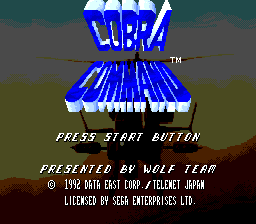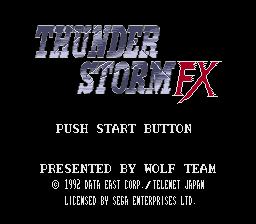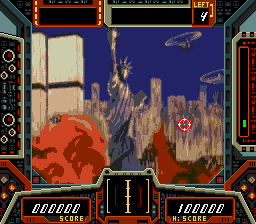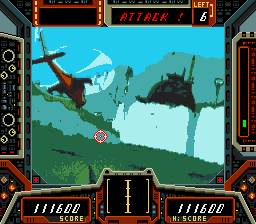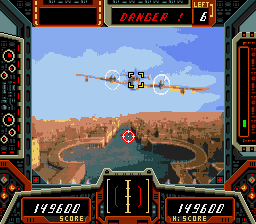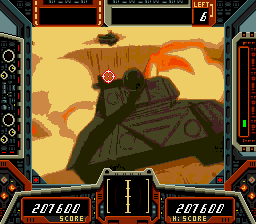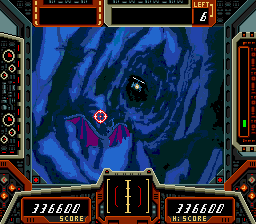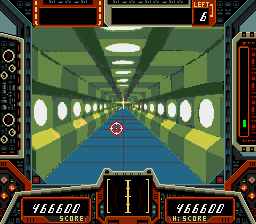Cobra Command
From Sega Retro
- For the Sega Saturn version, see Thunder Storm & Road Blaster.
| |||||||||||||||||||
| Cobra Command | |||||||||||||||||||
|---|---|---|---|---|---|---|---|---|---|---|---|---|---|---|---|---|---|---|---|
| System(s): Sega LaserDisc hardware, Sega Mega-CD | |||||||||||||||||||
| Publisher: Wolf Team (JP) Sega of America (US) | |||||||||||||||||||
| Developer: Wolf Team | |||||||||||||||||||
| Licensor: Data East, Telenet Japan Renovation Products (US) | |||||||||||||||||||
| Original system(s): Arcade boards | |||||||||||||||||||
| Developer(s) of original games: Data East | |||||||||||||||||||
| Genre: Shooting[1] | |||||||||||||||||||
| Number of players: 1 | |||||||||||||||||||
| |||||||||||||||||||
|
Cobra Command, known as Thunder Storm FX (サンダーストームFX) in Japan, is a full-motion video game developed by Wolf Team for the Sega Mega-CD and released in 1992. It is a port of the 1983 arcade game Thunder Storm by Data East, and it is an interactive movie produced by Toei Animation.
Contents
Story
Terrorists are threatening the free world and have amassed a diabolical force. Only the brave pilot of Cobra Command can vanquish the terrorist threat and save the free world from total destruction. The player assumes the role as pilot of the LX-3 Super Cobra helicopter (fictional, but similar to the Bell AH-1 SuperCobra).
Gameplay
The game is an interactive movie with elements of a shooter. The player watches scenes from a first-person perspective as the helicopter flies through the conflict zones. The game screen is represented by the helicopter's cockpit, and the player controls a crosshair that can be moved with the D-pad to aim at the enemy forces. The player can fire missiles with ![]() or
or ![]() or a Vulcan gun with
or a Vulcan gun with ![]() . Both weapons have unlimited ammunition. The Vulcan gun can be fired continuously by holding the button down but quickly overheats. The player must also occasionally use the D-pad to steer the helicopter out of the way of obstacles when cued. If the player fails to shoot down an enemy or move the helicopter in time, a short animated sequence depicts the Cobra helicopter being destroyed and the player loses a life. The game ends if the player runs out of lives.
. Both weapons have unlimited ammunition. The Vulcan gun can be fired continuously by holding the button down but quickly overheats. The player must also occasionally use the D-pad to steer the helicopter out of the way of obstacles when cued. If the player fails to shoot down an enemy or move the helicopter in time, a short animated sequence depicts the Cobra helicopter being destroyed and the player loses a life. The game ends if the player runs out of lives.
There are two selectable difficulty levels (Normal and Advanced). On both difficulty levels, the player is given vocalized instructions from a "flight instructor." When playing on Normal, the player is additionally given visual cues in the helicopter's HUD.
Stages
| New York | |
|---|---|
| Grand Canyon | |
| The Pacific | |
| Easter Island | |
| Small Enemy Fortress | |
| Rome | |
| Desert | |
| The Jungle | |
| Cave | |
| Main Enemy Fortress | |
History
The original arcade version was released in Japan on April 24th, 1984. It was the second LaserDisc game after Data East's Bega's Battle[5]. A conversion kit using the Bega's Battle cabinet was released, as well as conversion kits from Sega LaserDisc hardware such as Astron Belt[6].
In Europe, Cobra Command was later bundled with Sol-Feace, a horizontal shoot-'em-up, as Sol-Feace / Cobra Command. As European Mega-CD games were distributed in jewel case quad boxes, one "half" of the box was devoted to Cobra Command, and the other to Sol-Feace. In America, it was bundled with Road Avenger.
Legacy
The game was bundled with Road Avenger in the Sega Saturn game Thunder Storm & Road Blaster. It was later ported to iOS by G-Mode, the company that bought Data East's intellectual property after its bankruptcy.
Versions
Localised names
| Language | Localised Name | English Translation |
|---|---|---|
| English | Cobra Command | Cobra Command |
| English (US) | Cobra Command | Cobra Command |
| Japanese | サンダーストームFX | Thunder Storm FX |
Production credits
Mega-CD version
- Producer: J.Asanuma, M.Uno
- Director: K.Yokoh
- Planner: H.Suzuki, M.Norimoto
- Main Programming by: S.Hirachi
- Mega‑CD Programming by: C.Tokuhiro
- Visual Director: T.Okano, T.Konishi
- Design Supervised by: K.Nagata
- Graphics by: K.Tajima, M.Matsushima, A.Kabaya, M.Yasumori, H.Nakajima, Y.Nishitani, M.Kimura, K.Fujita, K.Tajiri, D.Moriyama, K.Ishiguro, M.Andou, Y.Inagaki
- Ending Music Compose by: M.Sakuraba
- Solid Gold
- Compose by: N.Nakamura
- Co.Arr & Play: H.Mizuno
- Music Coordinated by: T.Satoh
- Mixer's Lab
- Recording Engineer: S.Yoshii
- Assistant Engineer: Y.Oshima
- The Phenomenon Studio
- Manipulator: H.Shimahara
- Recording Studio: West Side
- Recording Director: H.Yamaguchi
- Avaco Creative Studios Inc
- MA Engineer: T.Uemura
- MA Assistant Engineer: M.Otsubo
- MA Director: N.Matsumoto
- Nittobo Acoustic Engineering Co. Ltd
- 3D Engineer: F.Tsutsumi
- 3D Director: T. Kobayashi
- 3D Producer: T.Shigeta
- Narration by: S.Herman
- MA Studio: Avaco Creative Studio
- Sound Producer: K.Senzaki
- Public Relations by: K.Iijima, E.Kobayashi, T.Murakami
- Thanks to: K.Gotoh, M.Uchida, T.Kunimatsu, I.Kadowaki, R.Ishizawa, H.Nina
- Special Thanks to: K.Fukushima
- Executive Producer: M.Akishino
- Licensed by: Data East Corp.
- All Produced by: Wolf Team
Magazine articles
- Main article: Cobra Command/Magazine articles.
Promotional material
Artwork
Physical scans
Mega-CD version
| 76 | |
|---|---|
| Based on 32 reviews | |
| Mega-CD, JP |
|---|
Technical information
- Main article: Cobra Command/Technical information.
References
- ↑ 1.0 1.1 https://sega.jp/fb/segahard/mcd/soft_licensee.html (Wayback Machine: 2019-06-10 17:56)
- ↑ Sega Visions, "November/December 1992" (US; 1992-xx-xx), page 93
- ↑ GamePro, "October 1992" (US; 1992-xx-xx), page 26
- ↑ 4.0 4.1 GamePro, "January 1993" (US; 199x-xx-xx), page 74
- ↑ Game Machine, "1984-05-15" (JP; 1984-05-15), page 13
- ↑ http://www.dragons-lair-project.com/tech/pages/cc.asp
- ↑ File:Cobracommand_MCD_JP_SSEnding.pdf
- ↑ 1700 igr dlya Sega, "" (RU; 2001-xx-xx), page 48
- ↑ Beep! MegaDrive, "August 1992" (JP; 1992-07-08), page 30
- ↑ Console Mania, "Novembre 1992" (IT; 1992-1x-xx), page 74
- ↑ Consoles +, "Septembre 1992" (FR; 1992-0x-xx), page 74
- ↑ Computer & Video Games, "November 1992" (UK; 1992-10-15), page 32
- ↑ Electronic Games (1992-1995), "January 1993" (US; 1992-12-10), page 92
- ↑ Electronic Gaming Monthly, "December 1992" (US; 1992-xx-xx), page 36
- ↑ Entsiklopediya luchshikh igr Sega. Vypusk 1, "" (RU; 1999-xx-xx), page 301
- ↑ Famitsu, "1992-09-04" (JP; 1992-08-21), page 40
- ↑ GameFan, "Volume 1, Issue 1: October 1992" (US; 1992-xx-xx), page 6
- ↑ Game Power, "Luigio/Agosto 1993" (IT; 1993-0x-xx), page 73
- ↑ Game Informer, "January/February 1993" (US; 199x-xx-xx), page 6
- ↑ Joypad, "Octobre 1992" (FR; 1992-10-xx), page 64
- ↑ Joystick, "Novembre 1992" (FR; 1992-1x-xx), page 164
- ↑ Sega Mega Drive Advanced Gaming, "November 1992" (UK; 1992-xx-xx), page 19
- ↑ Sega Mega Drive Advanced Gaming, "May 1993" (UK; 1993-xx-xx), page 47
- ↑ Mega, "November 1992" (UK; 1992-10-15), page 42
- ↑ Mega Fun, "11/92" (DE; 1992-10-xx), page 30
- ↑ Mega Fun, "09/93" (DE; 1993-08-18), page 35
- ↑ MegaTech, "November 1992" (UK; 1992-10-20), page 32
- ↑ Marukatsu Mega Drive, "September 1992" (JP; 1992-08-xx), page 120
- ↑ Mean Machines Sega, "October 1992" (UK; 1992-09-xx), page 22
- ↑ Sega Magazin, "September/Oktober 1993" (DE; 1993-09-01), page 14
- ↑ Sega Pro, "November 1992" (UK; 1992-10-08), page 30
- ↑ Sega Pro, "April 1993" (UK; 1993-03-11), page 74
- ↑ Sega Force, "4/93" (SE; 1993-07-08), page 16
- ↑ Sega Force, "November 1992" (UK; 1992-10-08), page 62
- ↑ Sega Saturn Magazine, "September 1995" (JP; 1995-08-08), page 85
- ↑ Supergame, "Novembro 1992" (BR; 1992-11-xx), page 16
- ↑ Tricks 16 bit, "Tricks Sega Gold 800 igr" (RU; 1998-03-20), page 44
- ↑ Video Games, "9/93" (DE; 1993-08-25), page 43
| Cobra Command | |
|---|---|
|
Main page | Comparisons | Hidden content | Development | Magazine articles | Reception | Technical information
Prototypes: 1992-10-10
| |
